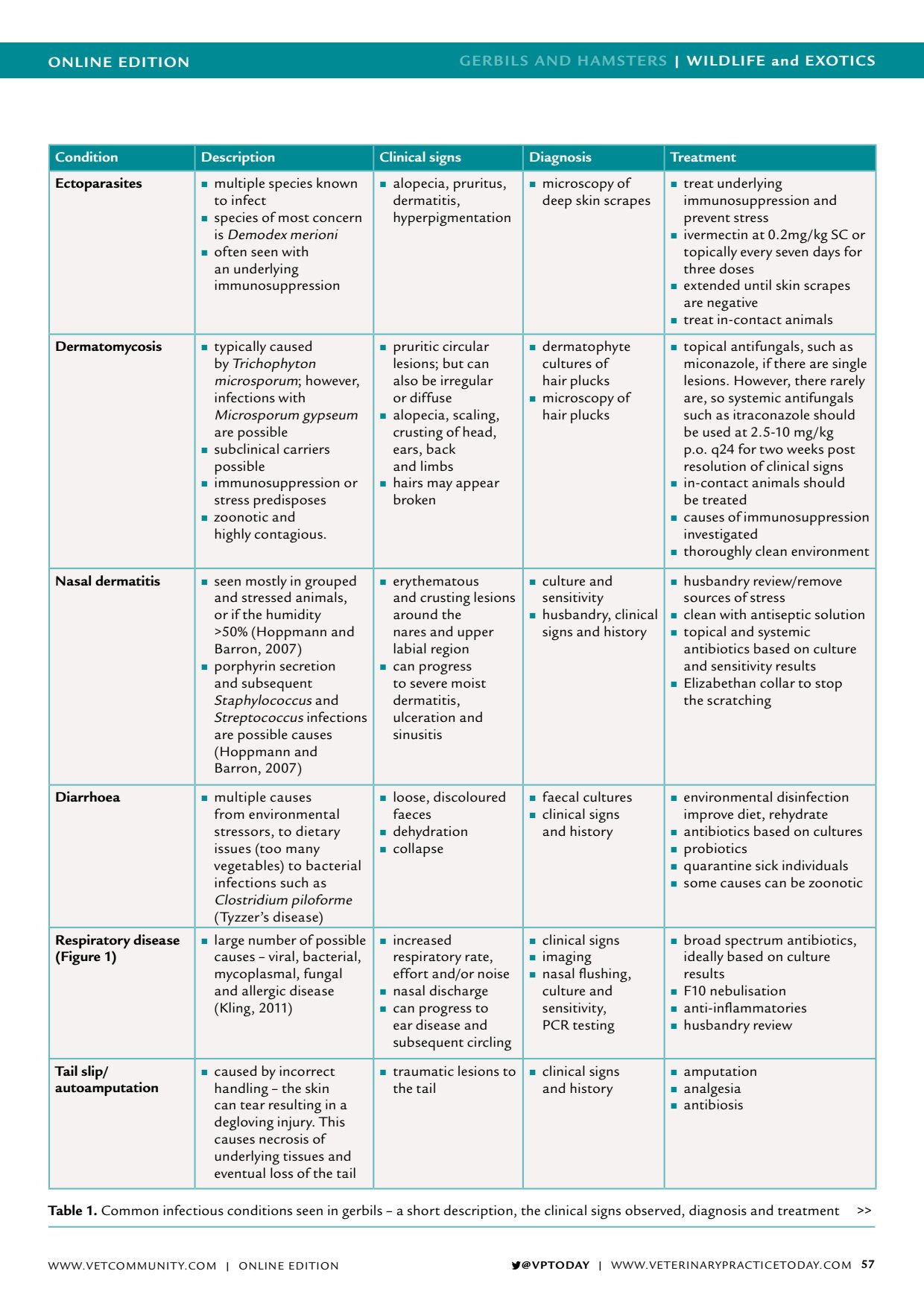ONLINE EDITION GERBILS
ONLINE EDITION GERBILS AND HAMSTERS | WILDLIFE and EXOTICS VPTODAY | WWW.VETERINARYPRACTICETODAY.COM 57 Condition Description Clinical signs Diagnosis Treatment Ectoparasites multiple species known to infect species of most concern is Demodex merioni often seen with an underlying immunosuppression alopecia, pruritus, dermatitis, hyperpigmentation microscopy of deep skin scrapes treat underlying immunosuppression and prevent stress ivermectin at 0.2mg/kg SC or topically every seven days for three doses extended until skin scrapes are negative treat in-contact animals Dermatomycosis typically caused by Trichophyton microsporum; however, infections with Microsporum gypseum are possible subclinical carriers possible immunosuppression or stress predisposes zoonotic and highly contagious. pruritic circular lesions; but can also be irregular or diffuse alopecia, scaling, crusting of head, ears, back and limbs hairs may appear broken dermatophyte cultures of hair plucks microscopy of hair plucks topical antifungals, such as miconazole, if there are single lesions. However, there rarely are, so systemic antifungals such as itraconazole should be used at 2.5-10 mg/kg p.o. q24 for two weeks post resolution of clinical signs in-contact animals should be treated causes of immunosuppression investigated thoroughly clean environment Nasal dermatitis seen mostly in grouped and stressed animals, or if the humidity >50% (Hoppmann and Barron, 2007) porphyrin secretion and subsequent Staphylococcus and Streptococcus infections are possible causes (Hoppmann and Barron, 2007) erythematous and crusting lesions around the nares and upper labial region can progress to severe moist dermatitis, ulceration and sinusitis culture and sensitivity husbandry, clinical signs and history husbandry review/remove sources of stress clean with antiseptic solution topical and systemic antibiotics based on culture and sensitivity results Elizabethan collar to stop the scratching Diarrhoea multiple causes from environmental stressors, to dietary issues (too many vegetables) to bacterial infections such as Clostridium piloforme (Tyzzers disease) loose, discoloured faeces dehydration collapse faecal cultures clinical signs and history environmental disinfection improve diet, rehydrate antibiotics based on cultures probiotics quarantine sick individuals some causes can be zoonotic Respiratory disease (Figure 1) large number of possible causes viral, bacterial, mycoplasmal, fungal and allergic disease (Kling, 2011) increased respiratory rate, effort and/or noise nasal discharge can progress to ear disease and subsequent circling clinical signs imaging nasal flushing, culture and sensitivity, PCR testing broad spectrum antibiotics, ideally based on culture results F10 nebulisation anti-inflammatories husbandry review Tail slip/ autoamputation caused by incorrect handling the skin can tear resulting in a degloving injury. This causes necrosis of underlying tissues and eventual loss of the tail traumatic lesions to the tail clinical signs and history amputation analgesia antibiosis Table 1. Common infectious conditions seen in gerbils a short description, the clinical signs observed, diagnosis and treatment >> WWW.VETCOMMUNIT Y.COM | ONLINE EDITION
